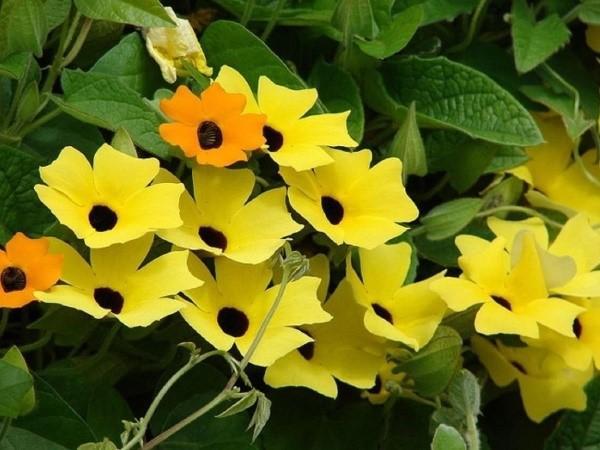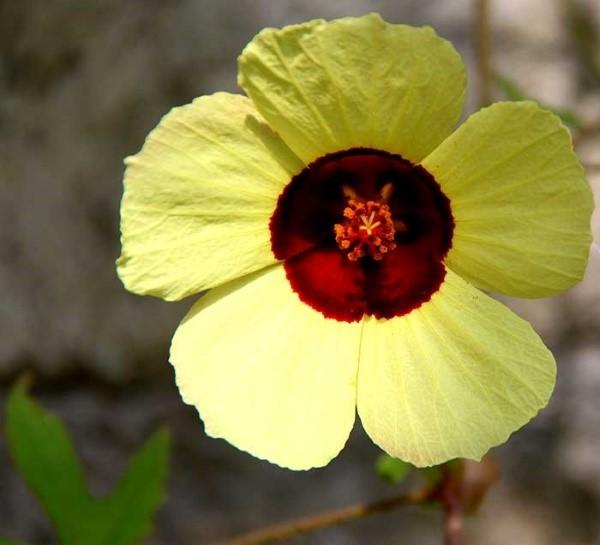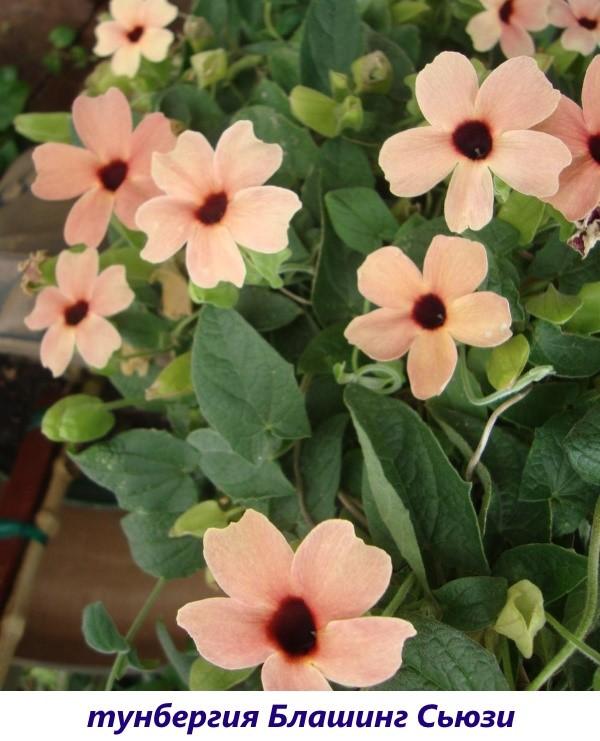The heat-loving, profusely blooming tunbergia will decorate your garden
 Do you have a gazebo or an arch on your site that needs to be decorated with a living wall, and preferably blooming? Then tunbergia is your right choice. Unpretentious care, fast growth, long branching lashes and a scattering of numerous chic inflorescences ... Isn't that what every gardener dreams of? Today we will talk about what Tunbergia is and how to grow it.
Do you have a gazebo or an arch on your site that needs to be decorated with a living wall, and preferably blooming? Then tunbergia is your right choice. Unpretentious care, fast growth, long branching lashes and a scattering of numerous chic inflorescences ... Isn't that what every gardener dreams of? Today we will talk about what Tunbergia is and how to grow it.
Description of the plant

The homeland of liana is the hot African tropics, where it grows as a perennial. However, the increased temperature requirements make it impossible to grow tunbergia in the garden in our climate all year round. The plant will not survive even the warmest winter in southern latitudes, therefore it is cultivated in the open field as an annual. But at home, tunbergia feels quite good. This allows the vine to be grown as a potted perennial crop.
Tunbergia has earned the love of gardeners thanks to its gorgeous flowering. In its native climate, it often blooms all year round, but in our country the buds begin to bloom in the middle of summer. Until the very middle of autumn, among the foliage on long pedicels, there are many bright funnel-shaped inflorescences.
In most species, the middle of the flower is dark, for which in European countries the plant is called "black Suzanne" or "tunbergia black-eyed Suzanne". There are also varieties with a yellow core: they are just as effective, but they look more delicate.
The flowers are not very large, only 4 cm in diameter, most often solitary, but have a very varied color. Depending on the variety, these can be delicate white, pink, yellow or blue tones. There are types with more saturated colors: purple, red and even brown. Some varieties of creepers have a pronounced sweet floral aroma, but most varieties do not. However, this in no way diminishes the effect and impression of the abundance and duration of flowering.
Popular types
Among the species diversity of flowering liana, it is worth noting the following types and varieties:
- Thunbergia winged Blushing Suzie. Shoot length up to 2 m, blooms in late June. Inflorescences up to 30 cm in diameter with a dark center and peach-pink petals.

- Tunbergia grandiflora or large-flowered. Shade-tolerant, long, curly shoots. Differs in large inflorescences up to 8 cm in diameter, collected in a lush brush. The middle of the flower is yellow, the petals are blue or light purple.

- Thunbergia is fragrant. Curly shoots, up to 6 m long. Flowers are white, completely open, but small, no more than 5 cm in diameter, with a strong sweet aroma.

- Tunbergia is erect. Shrub variety no more than 120 cm in height. Shoots are branched, but thin and need support. The flowers are small, purple with a yellow center.

- Tunbergia Mizorenskaya.Curly liana with shoots up to 5 m long. Differs in original long inflorescences with small red-brown flowers. They hang in clusters along the entire length of the branch and emit a pleasant aroma.

Tunbergia: planting and care in the open field
 As an annual in our climate, Tunbergia is grown with seeds. They sprout well and can hatch within a week after sowing. But the plant will bloom not earlier than 3 months after pinching. If sown directly to a flower bed, then tunbergia will bloom only at the end of summer and there will be little time left to admire its beauty. Do not forget that the bushes do not tolerate low temperatures, so early planting is not possible. Thus, it is best to grow liana in a seedling way.
As an annual in our climate, Tunbergia is grown with seeds. They sprout well and can hatch within a week after sowing. But the plant will bloom not earlier than 3 months after pinching. If sown directly to a flower bed, then tunbergia will bloom only at the end of summer and there will be little time left to admire its beauty. Do not forget that the bushes do not tolerate low temperatures, so early planting is not possible. Thus, it is best to grow liana in a seedling way.
Planting tunbergia seeds for seedlings
 Sowing should be started as early as possible, in late February - early March. A low container must be filled with loose, fertile soil mixture.
Sowing should be started as early as possible, in late February - early March. A low container must be filled with loose, fertile soil mixture.
You can take in equal proportions:
- leafy ground;
- humus;
- peat.
Considering that tunbergia seeds can remain viable for up to 2 years, it is advisable to soak them in a growth stimulator before sowing.
Seeds just need to be scattered over the surface and covered with a thin layer of soil. Spray abundantly on top from a spray bottle, cover the crops with foil and send them to a light windowsill. The optimum temperature for germination is not lower than 22 ° C. The greenhouse periodically needs ventilation, and the complete shelter can be removed in 1-1.5 weeks, when the seeds germinate.
Tunbergia seedling care
When the seedlings grow up, they need to be planted, otherwise, in crowded conditions, they will begin to fight for light and will stretch out. This can be done when a pair of true leaves is formed in the plants. You can avoid picking if you immediately sow seeds in peat pots. In each you need to put 2-3 seeds, "in reserve". If all sprout, it is advisable to leave the strongest and most developed sprout, and cut off the rest with scissors.
Although tunbergia and a vine with long shoots, it can grow quite lush with a little help during the seedling stage. To do this, you need to stimulate the development of lateral buds by pinching the tunbergia. This is especially true for bush forms of culture: after pinching, they branch better. The removal of the top growth point must be carried out when the bushes have reached a height of at least 12 cm.
Regarding feeding seedlings, then if fertile land was used for sowing with the addition of organics, it is not necessary. The available nutrients should be sufficient for the development of the seedlings. But if the goal is to get not flowering, but green mass for decorating gazebos, you can add nitrogen-containing preparations once a week.
In open ground, tunbergia seedlings can be transplanted in mid-May, but not before the frost leaves.
How to care for tunbergia in the garden
 As a heat-loving crop, blooming liana should be planted in a cozy place with good lighting. The shady nooks of the garden do not suit her - there the tunbergia will not be able to fully show its flowering. When planting in rows, it is important to leave at least 45 cm between the bushes. This culture grows well not only upward, but also in width. Near each plant, it is imperative to install a support along which the vine will "go" to the sides or up.
As a heat-loving crop, blooming liana should be planted in a cozy place with good lighting. The shady nooks of the garden do not suit her - there the tunbergia will not be able to fully show its flowering. When planting in rows, it is important to leave at least 45 cm between the bushes. This culture grows well not only upward, but also in width. Near each plant, it is imperative to install a support along which the vine will "go" to the sides or up.
Before planting, you can add a little lime to the flowerbed and dig up the area.

Further care for garden tunbergia is not difficult and consists in the following procedures:
- Moderate watering until the budding stage, and with the beginning of flowering - abundant. If the vine lacks moisture, it will shed both leaves and buds.
- Periodic "shower" bathing. If it is hot in summer and there is no rain, it will be useful to spray the crown of the plant, but only in the evening.
- Timely feeding.Until the end of summer, once a month, it is advisable to water the tunbergia with liquid complex fertilizer.
- Tying up shoots as needed.
At the end of flowering, in place of the inflorescences, seeds ripen in interesting elongated capsules. You must have time to cut them off before the capsules open, otherwise the tunbergia seeds will spill to the ground. They should ripen indoors: cut the boxes and pour the seeds onto paper.
With the onset of the first frost, the vine can be cut and removed from the site, or this work can be left for the spring. In any case, the bush will die in winter, so it makes sense to collect seeds for planting tunbergia next season.
Growing and caring for tunbergia indoors
 Like a liana, it will be more convenient to plant tunbergia indoors in hanging pots, or to make good support for it.
Like a liana, it will be more convenient to plant tunbergia indoors in hanging pots, or to make good support for it.
The soil should be light and nutritious, for example, a mixture:
- leaf and sod land;
- peat;
- sand.
This horticultural crop tolerates room air surprisingly well, but regular spraying will benefit it. The lighting should be bright, because the quality of flowering depends on it. However, the plant does not like direct rays and needs shading on the southern windows in the afternoon. In the summer, it is better to take the pot outside - there the bush can open up in all its glory. During this period, it is important to regularly water the flower, preventing the soil from drying out. In this case, care must be taken that excess moisture does not stagnate, otherwise root rot is not far off.
Since the feeding area of indoor tunbergia is limited, it is simply impossible to do without feeding a flowering perennial. Mineral complexes for flowering plants are suitable. Top dressing should be started before flowering when the buds are tied. It is enough to do this twice a month, and after the end of flowering (around the middle of October) there is no longer a need for them. Thunbergia needs to rest before next season.
Another difference between garden and indoor tunbergia is pruning. The first does not need it, since it completely dies during the winter. Indoor liana is grown as a perennial, and therefore needs pruning. Without it, the plant will lose its attractiveness and bloom worse. For the winter, it is necessary to radically shorten the shoots (up to 5 buds) and move the pot to a relatively cool room (no more than 15 ° C). During this period, watering should be rare. In the spring, it remains to pinch young twigs, if they do not branch, and the vine will again be lush.
As you can see, the African beauty Tunbergia has successfully taken root in our area. Despite the absolute intolerance to low temperatures, otherwise it is a completely non-capricious plant. So feel free to plant a vine in the garden and even in indoor planters and enjoy its abundant flowering!